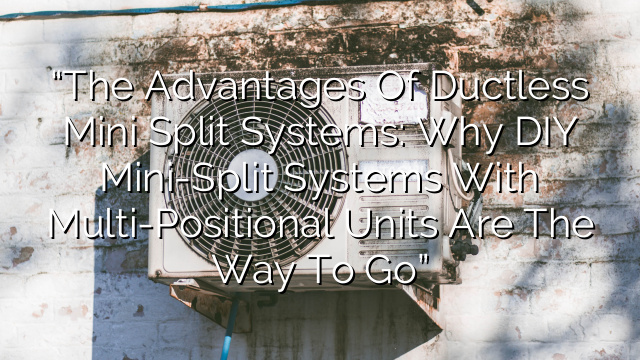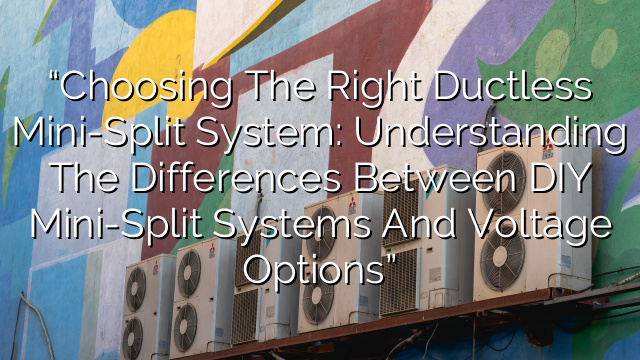Ductless mini split systems are becoming an increasingly popular choice for homeowners looking to efficiently heat and cool their homes. These systems offer a number of advantages over traditional HVAC systems, including improved energy efficiency, zoning capabilities, and easy installation. In recent years, many manufacturers have also started offering DIY mini-split systems, which allow homeowners to install the units themselves, rather than hiring a professional. While DIY installation may seem appealing, it’s important to consider the pros and cons before taking on this project.
The Pros of Ductless Mini Split Systems
Improved Energy Efficiency
One of the main advantages of ductless mini split systems is their improved energy efficiency. Unlike traditional HVAC systems, which use ductwork to distribute air throughout the home, mini splits deliver conditioned air directly to individual rooms. This eliminates the energy loss commonly associated with duct systems, resulting in lower energy bills and greater overall efficiency.
Zoning Capabilities
Another major benefit of ductless mini split systems is their zoning capabilities. With traditional HVAC systems, homeowners typically have to heat or cool their entire home, even if they’re only using certain rooms. Ductless mini splits offer the ability to individually control the temperature in each room, allowing for greater comfort and energy savings.
Easy Installation
The ease of installation is another advantage of ductless mini split systems. These systems are composed of an outdoor unit and one or more indoor units, which are connected by refrigerant lines. DIY mini-split systems are specifically designed for easy installation, with step-by-step instructions and minimal tools required. This can save homeowners both time and money, as they don’t have to wait for and pay for professional installation.
The Cons of Ductless Mini Split Systems
Limited Coverage
While ductless mini split systems are a fantastic option for many homeowners, they may not be the best choice for those with larger homes or unique layouts. The coverage of a mini split system is determined by the size and capacity of the indoor units and the strength of the outdoor unit. If not properly sized and placed, a mini split system may struggle to adequately heat or cool the entire home.
Higher Initial Cost
Compared to traditional HVAC systems, ductless mini splits often have a higher initial cost. This is due to the cost of the individual indoor and outdoor units, as well as any additional accessories needed for installation. However, it’s important to remember that the long-term energy savings of ductless mini split systems can help offset this higher upfront cost.
DIY Installation Challenges
While the promise of a DIY installation may be appealing, it’s important to consider the challenges that may arise. Installing a mini split system requires working with refrigerant lines, electrical wiring, and mounting hardware. If you don’t have experience or knowledge in these areas, it can be easy to make mistakes that could damage the system or pose safety risks. In some cases, DIY installation may also void the manufacturer’s warranty on the system.
Is DIY Installation Worth It?
Ultimately, the decision to install a ductless mini split system yourself or hire a professional depends on your comfort level with DIY projects, your budget, and the scope of the installation. If you have experience with similar projects and feel confident in your skills, DIY installation can be a cost-effective solution. However, if you have any doubts or concerns, it’s best to consult with a professional to ensure the system is installed correctly and safely.
FAQ
- Are ductless mini split systems more energy-efficient than traditional HVAC systems?
Yes, ductless mini split systems are generally more energy-efficient than traditional HVAC systems. The absence of ductwork reduces energy loss, resulting in lower energy bills and greater overall efficiency.
- Can I control the temperature in each room with a ductless mini split system?
Yes, one of the advantages of ductless mini split systems is their zoning capabilities. Each indoor unit can be individually controlled, allowing you to adjust the temperature in each room according to your preference.
- Can a ductless mini split system adequately heat or cool my entire home?
While ductless mini splits can effectively heat and cool many homes, their coverage is limited. The size and capacity of the units, as well as the strength of the outdoor unit, determine the coverage. Larger homes or homes with unique layouts may require multiple units for complete coverage.
- Are there any risks or challenges associated with DIY mini split system installation?
Yes, DIY installation can have risks and challenges. Working with refrigerant lines and electrical wiring requires knowledge and skill to avoid damage to the system or safety risks. Additionally, DIY installation may void the manufacturer’s warranty.
- Is DIY installation of a ductless mini split system recommended?
DIY installation is recommended for those with experience and knowledge in similar projects. However, if you have any doubts or concerns, it’s best to consult with a professional to ensure the system is installed correctly and safely.














